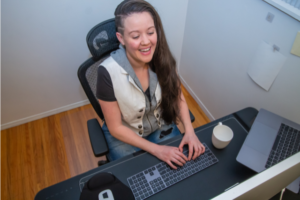Ever tossed and turned in bed, haunted by back discomfort? Have you ever noticed a change in your mood or energy levels after a night of uncomfortable sleep? Think about it as we explore how your spine’s alignment affects more than just your back. That pesky night-time foe? Poor spinal alignment, the ninja of discomfort.
If you’re seeking tips on how to align your spine in bed, you’ve come to the right place. Let’s unlock the mystery of bedtime posture, your secret weapon for dreamland victories.
How to Align Your Spine in Bed
In this comprehensive guide, we’ll dive into the whys and hows of aligning your spine in bed, not just to bid farewell to those irksome backaches but to embrace a holistic approach to health that starts with our spinal well-being. Let’s unravel the spine-aligning secrets for a sleep that’s both sound and serene.
Understanding Your Spine— Engineering Marvel

Ever paused to admire your spine’s genius? It’s more than a bone tower; it’s nature’s architectural masterpiece. Envision 33 vertebrae, each a marvel, forming a meticulous column from neck to lower back.
This spinal column does more than keep you upright. It’s a fortress safeguarding your spinal cord, the superhighway of your nervous system. Imagine nerve signals zipping up and down this highway, commanding every move, every sensation, every beat of your heart.
But wait, there’s a twist – literally! Your spine’s graceful curves are its superpower, acting like nature’s best shock absorbers. They cushion and distribute stress, letting you bend, twist, and shout (or maybe just stretch and yawn).
When these curves are out of whack, it’s not just a pain in the back. It can throw a wrench in the smooth operation of your nervous system, affecting everything from how quickly you react to a hot cup of tea to how your organs function smoothly.
Self-Alignment Techniques: Your Guide to a Spine-Friendly Slumber
 Understanding how to align your spine in bed is the first step towards a restful night and a pain-free morning. Ever wondered if your favorite sleeping position is helping or hindering your spine? Let’s find out.
Understanding how to align your spine in bed is the first step towards a restful night and a pain-free morning. Ever wondered if your favorite sleeping position is helping or hindering your spine? Let’s find out.
Transforming your bed into a sanctuary for spinal health is easier than you might think. With a few simple tweaks to your bedtime routine, you can realign your spine and wake up feeling rejuvenated.
Let’s look at eight ways you can take the reins of your spinal health each night:
- Mattress Matters: The foundation of good spinal health starts with your mattress. A medium-firm mattress is often the sweet spot, offering the perfect blend of support and comfort. Think of choosing a mattress as picking a dance partner for your spine – you want someone who supports you just right, don’t you? It hugs your spine supportively, maintaining its natural curve and ensuring even weight distribution.
- The Perfect Sleeping Pose: Start by lying on your back – it’s like hitting the reset button for your spine. This position distributes your weight evenly and aligns your spine naturally, giving your back the break it deserves.
- Pillow Talk: The right pillow placement is key. A pillow under your head should support your neck without tilting it upward. For an extra touch of comfort, roll a towel and slip it under your neck. It’s the little things that make a big difference.
- Lower Back Love: If you’re a back sleeper, slide a pillow under your knees. This isn’t just about comfort; it’s about maintaining that natural curve in your lower back, reducing strain, and showing your spine some love.
- Side Sleeper Strategies: For the side sleepers among us, use a supportive pillow like the Everlasting Comfort, to cradle your head, keep it in line with your spine, and place another more firm pillow between the knees. This dynamic duo prevents your spine from turning into a twisty pretzel as you dream.
- Stomach Sleeping? Think Again: For the stomach sleepers out there, a word of caution. This position can be a bit of a villain for your neck and back. It tends to twist your neck and arch your back in ways they’re not too fond of. If you can’t resist, a pillow under your pelvis can be your spine’s secret weapon, helping keep things more aligned.
- Morning Stretch Ritual: Before you jump out of bed, give your back a gentle wake-up call. A simple knee-to-chest stretch can work wonders in easing lower back tension. It’s like a good morning hug for your spine.
- The Art of Consistency: Remember, aligning your spine is a journey, not a sprint. Make these techniques part of your nightly routine for lasting benefits. It’s about building habits that show your spine the respect it deserves.
These self-alignment techniques offer a straightforward approach to how to align your spine in bed, ensuring each night contributes positively to your spinal health.
DIY Spinal Care: Your At-Home Spine Spa

Caring for your spine at home is both empowering and essential for maintaining overall spinal health. Here are some effective ways to realign your spine and hips, right in the comfort of your living room.
And remember, these simple yet effective techniques can be your first line of defense against everyday stresses that take a toll on your spinal health.
- Stretching Exercises: Daily stretches are a gift to your back, hips, and abdominal muscles. Gentle yoga poses like Cat-Cow, Child’s Pose, and Pelvic Tilts can be incredibly beneficial. Who knew acting like a cat or a cow in your living room could bring such wonders to your back?
- Core Strengthening: Fortifying your core muscles is crucial for spinal support. Engaging in exercises like planks, bridges, and leg lifts strengthens the core, providing a solid foundation for your spine.
- Proper Posture Awareness: Keep an eye on your posture throughout the day, whether you’re sitting at a desk, standing in line, or walking. Good posture is the constant guardian of your spinal health.
- Heat Therapy: Applying heat can work wonders for tense muscles. Using a warm compress or heating pad helps in relaxing muscles and aiding the realignment process.
- Hip Alignment Techniques: Simple exercises like hip bridges or lying leg raises are key to maintaining hip alignment. They support your lower back, forming a stable base for your spine.
- Regular Movement: Avoid staying in one position for too long. Frequent movement, stretching, or simply walking around can significantly benefit spinal health.
Incorporating these techniques into your daily life isn’t just about spinal care. Building habits shows respect for your spine. By regularly practicing these steps, you’re not only keeping your spine aligned but also promoting a healthier lifestyle.
Understanding the Timeline for Spinal Realignment
Realigning your spine is a personal experience, unique to each individual. The timeframe for seeing results can vary widely, shaped by how misaligned your spine is, your lifestyle choices, and how consistently you practice alignment techniques.
- Early Signs of Improvement: You might start feeling a noticeable difference in your comfort and flexibility in just a few weeks of dedicated practice. It’s a bit like gardening – plant the seeds of good habits, give it some time, and watch your spinal health bloom. Patience is key!
- Longer-term Transformations: For those dealing with more significant spinal misalignments, changes might unfold over a longer span – think several months to a year. It’s like watching a slow but rewarding transformation, where patience is your best companion.
 Remember, setting realistic goals is crucial in this process. Spinal realignment isn’t an overnight fix; it’s an ongoing commitment to your body’s well-being.
Remember, setting realistic goals is crucial in this process. Spinal realignment isn’t an overnight fix; it’s an ongoing commitment to your body’s well-being.
Regular visits to a healthcare professional are part of this commitment, offering valuable insights into your progress and adjustments to your routine.
Spotting the Signs of a Misaligned Spine
Understanding when your spine might be out of alignment is crucial to nip those issues in the bud. Keep an eye out for these five telltale signs that your spine could be waving a red flag for help:
- The Tale of Persistent Pain: Battling constant discomfort in your lower back or neck? It’s not just about toughing it out. This pain can be your spine’s way of saying, ‘Hey, something’s not right here!’
- The Uneven Stance: Ever noticed yourself standing a bit lopsided? If your shoulders or hips are doing their own version of the Leaning Tower of Pisa, it’s a hint that your spine might be off-balance.
- When Movement Feels Limited: Struggling to move or turn with ease? If turning to look behind feels like a Herculean task, it’s a sign your spine might need some TLC.
- The Headache and Fatigue Connection: Persistent headaches and feeling like you’re always running on empty? Your spine might be contributing more to these than you think.
- Posture Tells a Story: Noticed any changes in your posture lately? If you’re starting to resemble Quasimodo, it’s time to check in with your spine.
Recognizing these signs early can be your first step in getting your spine back on track and reclaiming your comfort.
Daily Steps to Keep Your Spine Aligned and Happy
 Keeping your spine in good shape isn’t just about occasional check-ups; it’s about weaving spine-friendly practices into your everyday life.
Keeping your spine in good shape isn’t just about occasional check-ups; it’s about weaving spine-friendly practices into your everyday life.
Here are five everyday habits and exercises to help prevent spinal misalignment. Consistently incorporating these habits not only aids in preventing discomfort but also contributes to better posture and increased mobility.
- Stretch and Strengthen: Make stretching a daily ritual, like your morning coffee. Yoga, Pilates, or even some good old stretching can do wonders. And hey, a strong core is like a superhero cape for your spine.
- Posture Awareness: Mind your posture – whether you’re desk-bound, queuing for coffee, or out for a jog. Good posture isn’t just for ballerinas; it’s for everyone who wants to keep their spine smiling.
- Ergonomic Environments: Create a workspace where your spine feels like royalty. The right chair, desk, and setup can make all the difference – no more hunching over like you’re guarding a secret.
- Lifting the Smart Way: Lift with your legs, not your back. Think of it as a mini workout – your spine will thank you for skipping the unnecessary strain.
- Diet and Hydration: You are what you eat, and so is your spine. A balanced diet and staying hydrated are like sending love letters to your spine, keeping it nourished and flexible.
Incorporating these daily habits not only supports your overall spinal health but also contributes to knowing how to align your spine in bed, ensuring you wake up refreshed and ready for the day.
Embracing Technology and Expertise for Superior Spinal Health
In this digital age, giving your spine the care it deserves comes with a techy twist. Here’s how technology and expert know-how can make a big impact for your spinal health :
- Wearable Tech for Posture Perfection: Devices like Upright Go are like having a tiny posture coach glued to you, giving you a nudge every time you start to slouch.
- Mobile Apps for Spinal Support: Apps like PostureScreen Mobile bring spine care into the 21st century. They’re like having a pocket-sized physiotherapist, offering analysis and exercise plans right at your fingertips.
- Seeking Professional Wisdom: There’s no replacing good old expert advice. Consulting with chiropractors, osteopaths, or physical therapists can open new doors in your spine care journey. Finding them is now a breeze with websites like Zocdoc and Healthgrades.
- Telehealth: Can’t make it to the clinic? Platforms like Teladoc and Amwell bring the spine experts to you, making personalized advice just a video call away.
By incorporating these technological tools and expert opinions into your spine care regimen, you’re employing a more comprehensive and effective approach to maintaining your spinal health.
A Final Thought: Discovering the Key to Spinal Wellness
 As we wrap up our spinal health saga, remember caring for your spine is a crucial chapter in your overall wellness story. Adopting the right sleep positions and regular exercise is just the start; there’s a whole world of spine-loving practices out there.
As we wrap up our spinal health saga, remember caring for your spine is a crucial chapter in your overall wellness story. Adopting the right sleep positions and regular exercise is just the start; there’s a whole world of spine-loving practices out there.
Curious about taking your spinal health to the next level? Unlock Your Spine by Rick Kaselj, targeting those tricky S-Curve issues, might just be your next adventure. It’s like finding a hidden treasure map for your spine. Why not take a peek and see how it fits into your wellness journey?
FAQs: Enhancing Your Spinal Health
1. How to align your spine in bed for better posture and comfort?
To straighten your spine in bed, lie on your back with a supportive mattress. Consider placing a pillow under your knees to maintain the natural curve of your spine.
2. How can I align my spine myself?
To align your spine yourself, engage in regular stretching and strengthening exercises. Wall Pilates, a low-impact version of Pilates (think Pilates 2.0), is an effective method for self-alignment, offering exercises that target spinal health. Additionally, maintaining mindful posture throughout the day and using ergonomic furniture can also help in maintaining proper spinal alignment.
3. What is the best spine position when sleeping?
The best spinal position while sleeping is on your back, as it allows your spine to rest in a neutral position. Using a supportive pillow under your head and knees can enhance alignment.
4. How do you decompress your spine while sleeping?
Decompress your spine by sleeping on a medium-firm mattress, using pillows strategically for support, and practicing gentle stretching exercises before bed.
5. How long does it take to realign the spine?
The time to realign the spine varies. Some may notice improvements within weeks, while others with more significant misalignments may see changes over several months to a year. Regular practice and consistency are crucial.


